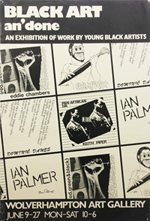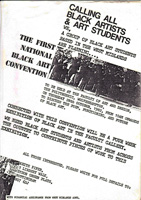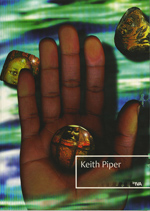Keith Piper is a British artist, curator, researcher and academic.

Born in 1960, Piper is a member of a generation of Black British subjects whose parents, during the 1950's formed the first mass wave of migration from the Caribbean, Indian Sub Continent and Africa. Raised within these newly formed settler communities, this generation was educated and socialised in many cases exclusively within a British context. However, this was a Britain which still carried with it racist ideologies, practices and attitudes derived from its colonial past.
Although challenged by political activism through the 1960's and 70's, this racism by the mid 1970's was still largely intact, and being sharpened by economic decline. The first waves of British educated young black people began to emerge from the school system into a 1970's landscape in which structural unemployment, an aggressively racist police force and a surge in neo-fascist activity combined to make the newly emerging status of 'Black Britishness' somewhat precarious.
The resultant radicalisation of this generation took a number of forms, the most dramatic of which found expression in the anti-police 'uprisings' which punctuated the period between the Notting Hill Riot of 1976 to the spate of 'riots' which ignited nationwide in 1981 to the Tottenham and other uprisings of 1985. (This history is explored in greater depth in Pipers digital paper 'Pathways to the 1980s', first presented at the Blk Art Group Symposium, Sheffield in Feb 2012)
| Pathways to the 1980s. Digital Paper in progress (Feb 2012) |
|---|
Piper was to spend his childhood and formative years in Birmingham, a city heavily hit by the industrial decline of the 1970's. In common with many young people of Caribbean descent his home context was marked by an adherence to the Christian fundamentalism which parents bought with them from their islands of origin. As with many young people of this generation, Piper underwent a rebellion against the passive structural conservatism which this background often enforced. However, as in all cases, the moment and mode of this rebellion is key. During the summer of 1976 which ended in riot in Notting Hill, Piper was busy studying for his O-Level exams. At the moment of Margaret Thatcher's notorious 'swamping speech' of 1978 and her accession to power in 1979, Piper was in throws of A-Level study. Although these events were at times referenced in Pipers teenage practice, it was only when in late 1979 when he first went to join the Foundation Course in Art and Design at Lanchester Polytechnic in Coventry that a more emphatically politicised practice was to begin to emerge.
Margaret Thatcher Swamping Speech 1978 |
 |
It was at Lanchester Polytechnic that Piper first met a young artist from Wolverhampton called Eddie Chambers. Like Piper, Chambers was a product of the rigorously formal, conservative and over-literal Seventh Day Adventist Church. Like Piper, Chambers had spent the latter part of his teenage years listening to the lyrics of radicalised Reggae music and reading the writings of Black American political figures in search of new certainties. Unlike Piper however, Chambers was already converting interests into positive action, bringing together a small group artist friends from the Wolverhampton region under the mentorship of local activist Eric Pembleton. He was already working towards the realisation of a small show by the 'Wolverhampton Young Black Artists Group' which would eventually be held in Wolverhampton Art Gallery in 1981 under the title "Black Art an' done". The line up of artists in the show included Chambers, Dominic Dawes, Andrew Hazel and Piper.
The period from 1981 to 1984 saw the 'Wolverhampton Young Black Artist Group' re-named as the BLK Art Group, and a series of exhibitions mounted around the UK under the title of 'The Pan-Afrikan Connection'. During this period the line up of artists would also shift and evolve. Claudette Johnson, an art student studying at Wolverhampton joined the group before the second show at the Africa Centre in Covent Garden in 1982. In 1980, following the one year foundation course in Coventry, Chambers went to study Fine Art at Sunderland Polytechnic and Piper went to Trent Polytechnic in Nottingham. In the following year, another young artist from Birmingham called Donald Rodney joined the Fine Art course at Trent, was introduced by Piper to Chambers and became involved in the Groups activities. In 1982, during a group exhibition at The Ikon Gallery another young Birmingham based artist, Marlene Smith introduced herself and became an active member.
This period was also characterised by the expanding networks of Artists from around the country. In 1982, the BLK art group organised the self proclaimed 'First National Black Art Convention' to be held at Wolverhampton Polytechnic. Contacts had already been made with veteran artist and activist Rasheed Aareen, London based artist Lubaina Himid and Shaka Dedi, director of the soon to be opened Black Art Gallery, all of whom spoke at the Convention. In the audience came first meetings with young London based artist Sonia Boyce, Brenda Agard and members of the Black Audio Film Collective. A plenary session called in response to Claudette Johnson's presentation to the conference is often cited as a key moment in forging the evolution of black women's creative practices which would emerge as a powerful strand of practice throughout the 1980's and beyond. Although the BLK Art group would only continue for another two years, a range of practices which would later begin to be characterised (perhaps problematically) as 'A Black Art Movement' began to emerge through the decade within the practice of a growing band of young artists of South Asian, African and Afro Caribbean descent. These artists were supported through a range of shared social spaces, through the curatorial energies of a number of artists activists such as Lubaina Himid, Rasheed Araeen, Joseph Olubu, Gavin Jantjes, Eddie Chambers and the space which became the Black Art Gallery directed first by Shakka Dedi and later by Marlene Smith. It was also supported through the slow, hard fought and painstaking opening up of public institutions and funding structures in response to these new practices throughout the decade.

Piper's practice continued to develop through the 1980's. Having completed his undergraduate degree at Trent Polytechnic in 1983, he went on to move to London to undertake an MA in Environmental Media at the Royal College of Art between 1984 and 1986. This period saw Piper staging his first solo show entitled 'Past Imperfect, Future Tense' at the Black Art Gallery, Finsbury Park, London.
During the 1980's, Pipers practice would see a development from a largely painting, collage and print based practice seen during the BLK Art Group shows, to an increasing embrace of mixed media and installation, utilising technology based elements. During his undergraduate degree show at Trent Polytechnic he was to use a combination of projected film loop, audio and sculpture for the first time within his practice. This integration of media would go on to characterise his practice during his MA studies at the RCA.
 |
 |
During this period Piper also migrated from the Amiga Computer platform to the Apple and became increasingly interested in the implications and utilisation of interactivity within the art viewing environment. When approached by InIVA (the Institute of International Visual Art) in the mid 1990's to stage a so called 'mid career' retrospective, he suggested a virtual rather than actual representation of past work through a series of interactive installations and virtual gallery spaces on a CD-Rom. This project evolved into 'Relocating the Remains' which toured to venues in the UK and USA from 1997 – 1999.
During this period some of the principal aims of the earlier 'black arts movement' around the visibility of the practice of black artists and their integration into the main stream of contemporary arts practice were in part realised by the historic successes of members of a younger generation of Black Artists with the awarding of the Turner Prize to Chris Ofili in 1998, and Steve McQueen in 1999.
In the year 2000 Piper performed a partial career shift taking up an Assistant Professors post in Electronic Media in the School of Fine Art in Carnegie Mellon University in Pittsburgh, USA. In 2003 he returned to the United Kingdom to take up a Principal Lecturers position in Media Production in the School of Cultural and Innovation Studies at the University of East London. In 2006 he took up a Readership in Fine Art and Digital Media at Middlesex University, London.